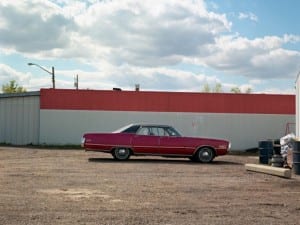Land Art – as a movement – emerged in 1960s and 1970s. Artists began to sculpt the earth into visually striking shapes, creating structures in the landscape using natural materials. One of the most famous examples is Robert Smithson’s Spiral Jetty, which is built into the Great Salt Lake in Utah. Over 50 years on, how are creatives responding to this tradition? Here are five Aesthetica Art Prize finalists who construct temporary interventions from a variety of media: from paint to recycled objects.

Victoria DeBlassie describes herself as an “ethno-archaeologist” – recognising and excavating materials after they’ve become “useless”, outdated or have decreased in value. DeBlassie recontextualises discarded objects and materials to create visually striking installation art. These works offer a strange kind of contrast: they are enthralling yet suggestive of excess, waste and throwaway culture.

Anthony Garratt’s outdoor piece bridges painting and installation. Titled High and Low, it responds to the landscape and history of North Wales. One four-and-a-half metre long canvas was installed on the mountain lake of Llyn Llydaw on Snowdon, whilst a second work was placed deep in an abandoned slate mine. Both were filmed over a period of six months as natural processes started to take hold.

James Tapscott’s otherworldly installations are temporary and site-dependent. Arc ZERO – Nimbus, for example, features a glowing archway that emerges from the trees of Omachi, Japan. A ring of mist encircles a bridge situated at the entrance to Hotokizaki Kanon-Ji. Other examples respond to locations across the world, from staircases in Taiwan to gallery spaces in China and pools of water in Melbourne.

Khao Mo (“mo” comes from “t’mo”, with roots in the Cambodian language) is a type of Thai art that originated in the Ayutthaya period (1351–1767). The concept behind Khao Mo is the replication of nature, and the desire to bring it closer to humans. Here, Pradittasnee responds to this concept. Stacks of mirrored boxes look to disappear and reappear again, depending on the viewer’s position and perspective.

Steve Messam
Steve Messam is an environmental artist based in the North East of England. His temporary, eye-catching installations – typically inflatable and “bigger than a house” – exploit colour and scale, creating a moment of interruption in the familiar. From working with farmers to re-imagining historic architecture, Messam’s ephemeral, site-specific art installations draw attention to hidden stories within the landscape.





